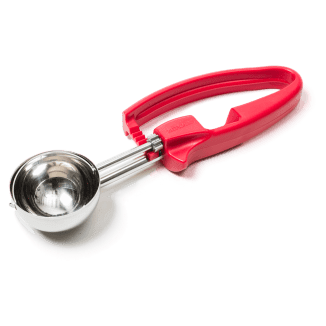Portion scoops, or cookie scoops, dole out identical servings of soft, difficult-to-manage foods, such as cookie dough, ice cream, and potato salad. Our favorite models are comfortable to operate for long periods of time, with plush grips and a just-right amount of resistance. They also dispense their contents cleanly and precisely. The OXO Good Grips Large Cookie Scoop ticked all these boxes, grabbing the top spot in our review. We also liked the two smaller versions of OXO’s scoops, sizes medium and small.

Portion scoops, sometimes called cookie scoops or dishers, come in a wide range of sizes and are handy for quickly and neatly dispensing uniform dollops of cookie dough, muffin batter, meatball mix, ice cream, and other soft, hard-to-wrangle foods. To operate them, you apply pressure to a spring-loaded handle, and a system of gears turns a thin, curved strip of metal inside each disher’s bowl. The metal strip sweeps around the bowl, dispensing its contents on demand.

Portion scoops fall into two categories. Thumb-press scoops operate using a lever that extends diagonally outward from the handle, which you depress with your thumb. Squeeze-style scoops have triangular handles: two sides connected at the bottom by a gear track, with a tension spring near the top; you use your whole hand to press the sides of the handle together.
It can be surprisingly hard to figure out what size the scoops actually are. Manufacturers identify scoops in different ways: by volume (listed in fluid ounces, tablespoons, or milliliters), by diameter, or, most commonly—and most confusingly—according to a numbered system unique to portion scoops. In this system, scoops are given numerical “sizes” based on the number of level scoops it would take to empty a quart. It would take 20 level scoops with a #20 size scoop, for example, and each scoop would hold about 3.2 tablespoons.

But in practice, manufacturers play fast and loose with this numbering system. We found that scoops of the same “size” could have capacities that varied by as much as a tablespoon. To get a portion scoop with the capacity we actually wanted, it was much more useful to look for information on the scoop’s volume, which each manufacturer usually lists alongside the inconsistent and unreliable numerical size.
With this in mind, we opted to focus our testing on scoops with listed capacities of about 3 tablespoons, which often corresponded to a #24 size scoop—the most common size—and are ideal for large cookies or meatballs. After identifying a winner, we tested versions of that scoop in smaller sizes, and we recommend those as well.
What to Look For
- Squeeze-Style Operation: Squeeze-style scoops were easier for testers of different hand sizes to operate.

- Accurate Capacity: Most scoops held the exact amount of food their manufacturers claimed they did or were off by no more than ⅓ of a tablespoon. This small bit of deviation was acceptable to us because it didn’t meaningfully change the yields or baking times of the recipes. Our winners held the exact volumes they were supposed to, which was our preference.
- Comfortable, Grippy Handles: Handles coated in rubbery material provided more cushioning and were easy to grip even when our hands got greasy from the buttery cookie dough.

- Moderate Tension: We liked scoops with springs that provided enough tension to operate predictably and consistently but didn’t have so much resistance that they were difficult to use. Models with moderate tension gave us a satisfying amount of feedback as we used them without tiring out our hands.
- Controlled Dispensing: We preferred scoops that dispensed servings with a smooth, controlled motion, which made it easier to predict where and at what angle dough balls would land, allowing us to place them precisely.

Nice to Have
- Dishwasher-Safe: While it wasn’t a requirement in our book, we did value models that were safe to put in the dishwasher, which minimized the effort it took to clean them.
What to Avoid
- Thumb Presses: All the thumb-press models we tested had levers that jutted too far outward—45 degrees or more—from the handle, which we found far more tiring to operate, especially for testers with smaller hands.

- Inaccurate Capacity: One scoop held almost a full tablespoon more than it purported to—increasing cookie sizes, decreasing recipe yields, and throwing off baking times by a few minutes at least.
- Smooth, Slippery Handles: Handles made of smooth metal or hard plastic tended to get slippery with food; we preferred handles made of soft, grippy plastic.
- Too Much Tension: Scoops with overly stiff springs tired our hands and fingers quickly.
- Untidy Dispensing: Several of the scoops flung their contents out in a somewhat haphazard way, gouging balls of dough in the process.
The Tests
- Measure actual capacity in both tablespoons and milliliters
- Portion a batch of Classic Chewy Oatmeal Cookies (versus a 1-tablespoon measuring spoon), timing how long it takes to complete each batch and weighing and measuring each cookie
- Have five testers—lefties and righties of different hand sizes—use and evaluate each scoop
- Squeeze each scoop 100 times
- Wash by hand or in dishwasher (according to manufacturers’ recommendations) for a total of 10 washes
How We Rated:
- Comfort: We noted which portion scoops were comfortable for testers of various hand sizes to grip and to squeeze.
- Control: We evaluated the scoops’ abilities to release dough in a clean, controlled motion.
- Accuracy: We measured the scoops’ actual capacities and compared them to those listed by the manufacturers to note whether they were accurate.




















